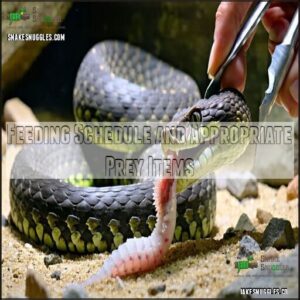This site is supported by our readers. We may earn a commission, at no cost to you, if you purchase through links.

Laws vary by state, and many require permits, so you’ll need to check local regulations first.
Rattlesnakes are venomous, meaning one bite can land you in the ER or worse, so safety precautions are non-negotiable.
Housing must be escape-proof, with precise temperature and humidity control to keep the snake healthy.
Costs add up quickly, from enclosures to veterinary care.
Plus, ethical concerns about keeping a wild animal make this a decision worth serious thought.
Ready for the challenge? There’s more to ponder.
Table Of Contents
- Legal Considerations for Keeping Rattlesnakes as Pets
- Risks and Dangers of Rattlesnake Ownership
- Proper Housing and Care for Pet Rattlesnakes
- Handling Techniques and Safety Precautions for Rattlesnakes
- Ethical Considerations of Keeping Rattlesnakes as Pets
- Cost Analysis of Rattlesnake Ownership
- Expertise Required for Responsible Rattlesnake Ownership
- Frequently Asked Questions (FAQs)
- Is it safe to have a rattlesnake as a pet?
- Can rattlesnakes be domesticated?
- Are there any friendly rattlesnakes?
- What snakes are illegal to keep as pets?
- Can I own a pet rattlesnake?
- Does a rattlesnake make a good pet?
- Can people own rattlesnakes?
- Can rattlesnakes be tamed?
- Can you adopt a rattlesnake?
- Is it legal to keep a rattlesnake as a pet?
- Conclusion
Legal Considerations for Keeping Rattlesnakes as Pets
Before you’ll be able to welcome a rattlesnake into your home, you’ll need to navigate a complex maze of state and local regulations that vary dramatically across the country.
You’ll find that while states like California allow certain rattlesnake species without permits, others like Delaware and Hawaii have completely banned private ownership, with violations potentially resulting in substantial fines and confiscation of your scaly friend.
State-specific Laws and Regulations
Rattlesnake legality turns out to be a patchwork quilt of regulations across the United States. Before bringing one of these venomous reptiles home, you’ll need to examine state laws and local ordinances that govern their ownership.
State laws on rattlesnake ownership fall into five distinct categories:
- Complete prohibition states like Delaware, Hawaii, and Illinois where ownership is illegal
- Permit-required states including Florida, Texas, and Pennsylvania
- No-permit states such as California, Montana, and Wyoming
- States with county-specific or municipal restrictions
- States with transportation laws limiting how these animals can be moved
Even in states allowing ownership, local ordinances might impose stricter restrictions. For example, while Arkansas permits many non-native species, specific regulations under Code 9.02 apply, and some cities like Pasadena have their own limits on venomous snake sales. It’s vital to review reptile ownership laws before acquiring any reptile, considering the various regulations and local restrictions to ensure compliance with the law and responsible pet ownership.
Permit Requirements and Restrictions
Traversing the maze of permit requirements for rattlesnake ownership can be challenging.
You’ll need to secure specific permits costing anywhere from $20 to $60 depending on your location and intended use.
State laws and local ordinances vary dramatically—some require proof of experience or age restrictions (must be over 18), while others may grant exceptions with a simple $35 hunting license.
Interstate transport faces strict legal restrictions, and exotic pet regulations change frequently.
Before bringing a venomous serpent home, verify your state’s rattlesnake legality status and complete all required paperwork.
Remember, these requirements aren’t arbitrary—they’re designed to safeguard public safety.
Penalties for Illegal Possession
Permit requirements are strict, but violating them brings severe consequences.
The legal hammer falls hard on illegal rattlesnake owners.
If you’re caught with an unauthorized rattlesnake, expect:
- Fines and Imprisonment: Penalties range from $500-$100,000 and potential jail time depending on state laws and severity of violations
- Confiscation Policies: Authorities will seize your snake without compensation and you’ll bear responsibility for associated costs
- Criminal Charges: Beyond local ordinances, interstate transport can trigger federal violations
State laws don’t make exceptions for well-intentioned hobbyists.
Legal interpretation varies by jurisdiction, but exotic pet regulations universally prioritize public safety over rattlesnake pet ownership desires.
Exceptions for Captive-bred Albino Rattlesnakes
Looking for a loophole in those strict penalties? Captive-bred albino rattlesnakes offer a unique exception in some states’ laws.
California explicitly exempts these genetic mutations from permit requirements—no license needed for possession, breeding, or even interstate transport of these distinctive color morphs.
While market demand for these specialized reptiles continues to grow, you’ll need to verify albino legality in your specific location.
Each state has different exotic animal laws regarding pet ownership.
Even with these exemptions, remember that venomous snake ownership still demands proper safety protocols.
Despite their typically calmer temperaments compared to wild-caught specimens, these captive-bred snakes remain potentially dangerous pets requiring specialized knowledge and secure handling.
Risks and Dangers of Rattlesnake Ownership
You’ll face potentially lethal consequences if your rattlesnake delivers a venomous bite, as these reptiles can strike with lightning speed and cause severe medical complications requiring expensive antivenin treatment.
A rattlesnake’s bite delivers venom with lightning speed, leading to costly medical care and life-threatening complications if untreated.
Your household’s safety is also compromised by the unpredictable nature of these animals, which can escape their enclosures and pose significant threats to family members, visitors, and pets alike, leading to severe medical complications.
Venomous Bites and Potential Fatalities
The lethal reality of rattlesnake ownership can’t be understated when considering potential bites.
As the leading cause of venomous snakebite fatalities in America, rattlesnake bites are four times more likely to cause serious injury or death compared to copperhead encounters.
Without prompt treatment, victims face a grim 48-72 hour countdown.
Bite symptoms escalate quickly:
- Your limb swells violently as tissue begins to die
- Your lungs struggle for air as airways constrict
- Your blood stops clotting, causing internal hemorrhaging
- Your kidneys may fail permanently, even with treatment
Antivenom access is essential but expensive, costing thousands per vial with multiple vials often needed.
Even with treatment, 10-44% of survivors face permanent disabilities.
First aid knowledge isn’t optional—it’s survival.
Liability Issues and Insurance Concerns
Beyond the venom risks, owning a rattlesnake creates serious financial hazards.
Your standard homeowner’s insurance won’t touch these scaly liabilities—they’re explicitly excluded as "exotic animals."
You’ll need specialized exotic pet insurance with liability coverage ranging from $25,000 to $250,000.
Insurers demand documentation of your secure housing setup and handling qualifications.
Without proper coverage, a single bite liability case or negligence claim could bankrupt you, making rattlesnake ownership a potential financial disaster for public safety.
Impact on Household Safety
While insurance concerns are important, your family’s wellbeing is at stake when a rattlesnake enters your home.
These venomous reptiles present serious household safety challenges:
- Children may be attracted to the novelty of a snake enclosure
- Pets often approach rattlesnakes out of curiosity, risking fatal bites
- Visitors unfamiliar with rattlesnake safety protocols face unexpected dangers
- Emergency access to anti-venom becomes critical when minutes count after a bite
Don’t underestimate a rattlesnake’s escape abilities—they can slip through surprisingly small openings.
Ecological Risks of Escaped Rattlesnakes
The ecological impact of an escaped rattlesnake extends far beyond your property, creating significant ecosystem disruption that can persist for years.
When your pet rattlesnake escapes, it becomes a nonnative species that threatens delicate ecological balance.
Consider these serious consequences:
- Prey impact: Rattlesnakes hunt efficiently, potentially decimating local small mammal and bird populations that aren’t evolved to avoid this specific predator
- Native species competition: Your former pet competes with indigenous reptiles for limited food, shelter, and territory resources
- Hybridization risks: Escaped captive rattlesnakes may breed with wild populations, weakening genetic diversity essential for species resilience
Wildlife conservation experts emphasize that rattlesnakes outside their natural habitat rarely thrive themselves, often suffering while simultaneously disrupting established ecological systems.
This creates a double threat to both public safety and ecological protection efforts, making proper containment essential for responsible ownership.
Proper Housing and Care for Pet Rattlesnakes
You’ll need a secure, escape-proof enclosure with proper temperature gradients to house your rattlesnake safely, as these venomous reptiles require specialized environments to thrive in captivity.
Your rattlesnake’s habitat must also include appropriate hiding spots, substrate, and a reliable water source, while regular monitoring for health issues is essential for responsible ownership.
Regular monitoring for health issues is a critical aspect of ensuring your rattlesnake’s well-being, and it requires a reliable water source to be consistently available.
Secure Enclosure Design and Materials
While the dangers of rattlesnake ownership are significant, proper housing is your first line of defense against potential disasters.
When designing a rattlesnake enclosure, safety isn’t just important—it’s everything. You’ll need 1/4-inch thick glass or reinforced PVC with industrial-grade locks that a curious snake can’t outsmart.
Your secure terrarium must feature ventilation needs with mesh openings smaller than your snake’s head—they’re more flexible than you might think. All corners should be sealed to eliminate escape routes, and incorporating a shift box system allows for cleaning without direct handling.
Proper ventilation is also essential for maintaining a healthy environment. Many owners prefer double-door systems for added enclosure security. Never use materials with potential toxicity that could harm your snake.
While size requirements matter, escape prevention features trump everything else when housing these powerful reptiles. Consider housing your enclosure in a dedicated, lockable room for maximum safety.
Temperature and Humidity Requirements
Every rattlesnake requires precise temperature control for survival in captivity. As ectothermic creatures, they depend entirely on environmental heat regulation for proper digestion and immunity.
Your terrarium must maintain an ideal gradient of 75-85°F with basking spots reaching 90-100°F. Monitor humidity levels between 40-60% using a reliable hygrometer to support healthy shedding humidity requirements.
For effective environmental control:
- Install multiple thermometers throughout the enclosure to verify your thermal gradient remains stable
- Program night temperatures 5-10°F cooler to mimic natural conditions
- Implement seasonal changes by slightly adjusting temperatures quarterly to replicate natural cycles
Many captive rattlesnakes develop respiratory infections from improper humidity. You can find a terrarium thermometer here for monitoring temperature. Remember, these aren’t like mammalian pets—temperature fluctuations that merely inconvenience you could prove fatal to them.
Feeding Schedule and Appropriate Prey Items
With proper temperature control in place, you’ll need to establish a reliable feeding regimen for your captive rattlesnake. Adult specimens typically require meals every 10-14 days, while younger snakes need more frequent feeding—usually once weekly.
Always use frozen-thawed rodents rather than live prey, which can injure your snake during feeding. To guarantee a safe and healthy diet, you can easily buy frozen feeders online.
You’ll want to:
- Select prey items 1-1.5 times the width of your snake’s mid-body for ideal nutrition
- Gut-load feeder rodents with nutritious foods before freezing them yourself
- Dust prey occasionally with calcium and vitamin supplements, particularly for growing rattlesnakes
Never microwave prey items—this creates dangerous hot spots that can harm your snake internally. Instead, thaw rodents in cool water, then warm to room temperature. Always use proper handling tools like snake hooks or feeding tongs to maintain a safe distance during meals.
Health Monitoring and Veterinary Care
Regular health monitoring serves as your first line of defense against rattlesnake ailments. Finding a vet experienced with venomous reptiles should be your priority before bringing home a rattlesnake.
Implement parasite prevention and quarantine protocols for new specimens. If your pet suffers a snakebite, seek immediate veterinary care—with prompt treatment including IV fluids, antibiotics, and antivenin, most pets survive these dangerous encounters.
| Observation Area | Warning Signs | Action Required |
|---|---|---|
| Behavior | Lethargy, unusual aggression | Document changes |
| Physical condition | Scale issues, swelling | Immediate vet visit |
| Eating patterns | Refusal to eat, regurgitation | Consult specialist |
| Enclosure hygiene | Mold growth, parasites | Deep clean habitat |
It is crucial to monitor your pet’s health closely and take action at the first sign of trouble, as prompt treatment can significantly improve outcomes in cases of snakebite or other health issues.
Handling Techniques and Safety Precautions for Rattlesnakes
You’ll need specialized equipment, including snake hooks, tongs, and protective gear, to safely handle a rattlesnake without putting yourself at risk of a potentially fatal bite.
Even with proper tools, never attempt to handle your rattlesnake without extensive training from an experienced mentor, as these venomous reptiles can strike with lightning speed when they feel threatened.
Specialized Tools for Safe Handling
Three essential snake handling tools stand between you and a venomous bite when working with rattlesnakes. Never underestimate the importance of professional-grade equipment—your life literally depends on it.
The rattlesnake handler’s arsenal includes:
- Snake hooks (24-40 inches) – Allow you to guide your snake without direct contact, keeping your hands safely distant from fangs
- Specialized tongs (minimum 36 inches) – Provide secure grip while maintaining control during necessary handling
- Shift boxes – Enable safe transfers between caging options during maintenance
Tong length should exceed your rattlesnake’s body length by at least 50%. When pinning rattlesnakes becomes necessary, use proper snake hooks with adequate reach. Consider purchasing handling tools for safety. Quality glove materials offer additional protection but shouldn’t replace proper handling tools—they’re your backup, not your primary defense.
Protective Gear and Equipment
Safety forms the foundation of rattlesnake handling, requiring specialized protective gear that can literally save your life. You’ll need bite-resistant gloves made from Kevlar or similar materials that withstand penetration far better than standard work gloves.
Snake hooks keep you safely beyond striking range, while proper tongs (at least 30% longer than your snake’s length) provide precise control without injuring the reptile. For hand safety, it’s essential to have puncture-resistant handling gloves.
Don’t forget transparent face shields to protect against upward strikes and a shift box for safe enclosure transfers. Bite suits offer full-body protection for high-risk scenarios. Always inspect your snake handling tools before use—a torn glove won’t protect against lightning-fast fangs, and you’ll only notice the failure when it’s too late.
Emergency Protocols for Potential Bites
Beyond protective gear, knowing what to do in a bite emergency could save your life. If a rattlesnake strikes, time becomes your enemy—immediate action is non-negotiable.
When a bite occurs, call 911 immediately. Position the affected area below heart level while awaiting emergency responders. Remove constricting items like rings or watches, and apply a clean bandage without restricting blood flow.
- Bite symptoms progress rapidly: intense pain, progressive swelling, and potential tissue damage can occur within minutes
- Antivenin access varies dramatically by location—many rural hospitals don’t stock sufficient quantities
- First aid focuses on immobilization and professional medical care, not outdated techniques like suction or tourniquets
Never attempt to drive yourself to the hospital. Remain calm and still to slow venom circulation while waiting for transport.
Training and Certification Requirements
Beyond emergency bite protocols, professional training stands between you and legal rattlesnake ownership.
Level 2C Venomous Handling Courses cover essential skills like identification, proper care, and safe handling techniques. You’ll need to pass both written and practical tests, though these certifications don’t replace state permits or legal requirements.
| Training Component | What to Expect |
|---|---|
| Live Practice | Start with non-venomous snakes before progressing to rattlesnakes |
| Permit Process | Mandatory facility inspections to verify compliance |
| Wildlife Breeders License | Often required for hobbyists |
| First Aid Certification | Typically mandatory |
Most states mandate continuing education and expertise verification through refresher training. Snake laws vary substantially—nuisance trappers need permits when handling live specimens, while those who euthanize on-site don’t.
Ethical Considerations of Keeping Rattlesnakes as Pets
You’ll need to weigh both conservation impacts and animal welfare concerns before bringing a rattlesnake into your home, as these wild creatures often suffer from stress and health problems in captivity.
Considering non-venomous snake alternatives won’t just protect your family and community from potential danger, but it’ll also support wildlife conservation efforts that aim to preserve these important predators in their natural habitats.
Animal Welfare Concerns
Five key animal welfare concerns challenge the ethics of rattlesnake ownership:
Captive rattlesnakes face stress, limited space, and lack of natural behaviors, raising serious ethical concerns for responsible ownership.
- Spatial deprivation – Captive rattlesnakes experience severe restriction in enclosures that are tiny fractions of their natural range
- Behavioral limitation – Unable to hunt, establish territory, or engage in natural mating rituals
- Captivity stress – Wild-caught specimens often refuse food and exhibit signs of distress when confined
- Enrichment needs – Most owners fail to provide adequate environmental complexity for mental stimulation
- Venom extraction harm – "Milking" procedures cause significant stress and can physically damage the snake
You’re responsible for their complete wellbeing, not just survival—a challenge few owners truly meet.
Conservation Implications
While animal welfare focuses on individual snakes, rattlesnake ownership also impacts entire species and ecosystems.
When you bring a rattlesnake into your home, you’re participating in a system that affects wild snake populations.
Rattlesnakes serve as natural pest controllers in their native habitats, helping maintain the delicate balance of ecosystems.
Unfortunately, the pet trade has contributed to significant conservation challenges:
- Over-collection from wild populations depletes natural breeding stock
- Habitat fragmentation occurs when collectors disturb natural environments
- Genetic bottlenecks develop when too many snakes are removed from specific regions
Conservation-minded ownership means sourcing only from legitimate captive breeding programs and never releasing pet rattlesnakes into non-native environments, which can disrupt local wildlife conservation efforts and cause irreparable ecosystem impact.
Public Perception and Social Responsibilities
The perception of rattlesnake ownership extends far beyond your living room walls, creating ripples throughout your community.
The challenges associated with owning a rattlesnake can be summarized as follows:
Your neighbors’ attitudes typically range from uneasy curiosity to outright fear, largely shaped by media portrayals that emphasize rattlesnakes’ dangerous reputation.
By addressing these concerns proactively with public education about your safety measures, you’ll demonstrate commitment to responsible pet ownership while tackling the complex conservation ethics of keeping venomous species.
Remember, you’re not just managing snake risks—you’re managing community impact and potentially influencing public safety regulations for all exotic pet owners.
Alternatives to Rattlesnake Ownership
If rattlesnakes feel like too much risk, you’ve got safer options that still scratch your reptile itch.
Consider these alternatives:
- Corn Snakes, King Snakes, and Ball Pythons: These non-venomous beauties are beginner-friendly and come in stunning colors.
- Reptile Sanctuaries: Volunteer at wildlife centers to work with venomous snakes safely.
- Education Programs: Join workshops or virtual classes to expand your snake knowledge.
- Alternative Pets: Yellow rat snakes or other non-venomous species make excellent companions without the danger.
Explore these paths guilt-free!
Cost Analysis of Rattlesnake Ownership
You’ll need to prepare your wallet for a significant financial commitment when keeping a rattlesnake, with costs spanning from specialized enclosures and handling equipment to potential medical expenses and insurance premiums.
Beyond the initial purchase price of $100-$500 per snake, you’ll face ongoing expenses for permits, feeding, veterinary care, and possibly legal fees that can quickly accumulate to thousands of dollars annually.
The total cost of keeping a rattlesnake can be substantial, making it essential to consider these expenses carefully and plan for the long-term financial commitment.
Initial Purchase and Setup Expenses
Starting your rattlesnake journey isn’t cheap, but it’s manageable with planning.
Expect Enclosure Costs of $200-$500 for a secure terrarium. Add $30-$100 for Heating Equipment and lighting to mimic its natural habitat.
Factor in Veterinary Setup and Initial Permits, which start at $120 combined. A rattlesnake cost ranges from $100-$500 depending on species.
Don’t skip specialized tools like hooks and tongs ($50-$75)—they’re non-negotiable for safety when handling these exotic pet snakes.
Ongoing Care and Maintenance Costs
In the context of ongoing rattlesnake care, costs can slither higher than you might expect.
Beyond the initial setup, you’ll face regular expenses that keep your snake healthy and safe.
- Feeding Costs: Pre-killed mice run $5–$6 each, totaling about $50–$60 monthly. Bulk buys might save a few bucks.
- Enclosure Upkeep: Expect to replace heating elements, UVB bulbs (every 6–8 months), and substrate (every 3–4 months).
- Enrichment Expenses: New hides, climbing structures, and décor prevent stress and boredom.
Veterinary care is another big-ticket item. Specialized snake veterinary bills, including medications, don’t come cheap, so budget carefully.
Owning a rattlesnake isn’t just thrilling—it’s a serious financial commitment.
Medical and Insurance Expenses
A rattlesnake bite isn’t just dangerous—it’s expensive. Medical and veterinary expenses can spiral quickly, so planning ahead is key.
Here’s what you’re looking at:
- Antivenom costs: Treatments can hit $213,278, with total bite treatment expenses exceeding $244,995.
- Even with health insurance, out-of-pocket costs might still reach $7,200.
- Exotic veterinary care for your snake’s health issues adds to the long-term care expense.
Ensuring proper care also involves understanding snake-specific medical needs.
Pet insurance for reptiles is affordable, averaging $9 monthly, but it’s limited. Since most homeowners’ policies exclude exotic pets, specialized insurance liability coverage is smart.
And always keep an emergency fund for unexpected veterinary expenses!
Potential Fines and Legal Fees
Skipping a permit isn’t just risky—it’s expensive.
Ownership penalties for illegal breeding or unpermitted rattlesnakes can lead to hefty fines, confiscation fees, and even criminal charges.
Defense costs skyrocket if liability coverage doesn’t apply, especially after a bite incident.
Local laws and municipal regulations complicate things further, and legal loopholes rarely hold up in court.
Hiring an attorney to navigate legality issues can cost more than the snake itself.
Always verify laws to avoid financial disasters.
Expertise Required for Responsible Rattlesnake Ownership
If you’re thinking about keeping a rattlesnake, you’ll need serious expertise to do it safely and responsibly.
Handling venomous snakes requires proper training, an understanding of their care needs, and the ability to spot health issues before they become dangerous.
Experience With Venomous Snake Handling
Handling venomous snakes like rattlesnakes isn’t a casual hobby—it demands skill and discipline.
You’ll need proper training to master safe handling techniques and minimize risks.
Experts recommend:
- Hands-on mentorship with certified herpetologists to learn venom extraction and bite prevention.
- At least 500 hours of supervised practice with non-venomous or mildly venomous species before attempting rattlesnake handling.
- Deep species knowledge, including envenomation symptoms and emergency response protocols.
Essential gear includes sturdy snake handling gloves for protection.
Even pros stay cautious; one careless moment could mean a costly hospital visit—or worse.
Understanding of Proper Husbandry Practices
Getting rattlesnake husbandry right means thinking like a scientist and a locksmith.
Secure enclosures with redundant locks are your first defense against escape.
For proper rattlesnake care, maintain a temperature gradient to mimic nature, and keep humidity in check to avoid shedding issues or respiratory problems.
Feeding rattlesnakes? Use tools to stay safe and stick to a consistent feeding frequency.
Add enclosure enrichment like hides or rocks to reduce stress.
Don’t overlook water quality—it’s essential.
Master these basics, and your rattlesnake as a pet will thrive.
Ability to Recognize and Address Health Issues
Spotting signs of snake illnesses is your first line of defense in maintaining good rattlesnake health. Keep an eye on your snake’s appetite, shedding patterns, and overall behavior—changes here often hint at underlying issues. A healthy snake should have clear eyes, smooth scales, and eat regularly.
If you notice erratic feeding or shedding problems, act fast. Quick access to a reptile vet is non-negotiable. Many health issues, like nutritional deficiencies or infections, worsen quickly without proper snake medication.
Regular checkups and a solid quarantine protocol for new snakes can prevent disease spread.
- Pro tip: Document your snake’s weight and feeding habits to spot problems early. It’s like keeping a health journal—for a scaly roommate!
Frequently Asked Questions (FAQs)
Is it safe to have a rattlesnake as a pet?
Owning a rattlesnake isn’t exactly safe.
Their venomous bites can be deadly, and they require specialized care, secure enclosures, and handling expertise.
Without proper precautions, they’re a danger to you, your family, and your community.
Can rattlesnakes be domesticated?
Rattlesnakes can’t be domesticated like cats or dogs.
They remain wild, instinct-driven animals, even in captivity.
You can habituate them to human presence, but their behavior stays unpredictable, and they don’t form bonds with people.
Are there any friendly rattlesnakes?
A rattlesnake’s charm is all bark and no bite—until it bites.
They’re not friendly by nature, staying defensive and solitary.
While fascinating, they’ll never warm up to you like a dog or cat might, and their defensive nature makes them a solitary creature.
What snakes are illegal to keep as pets?
Some snakes, like venomous species (e.g., cobras, mambas, vipers) and invasive species like Burmese pythons, are illegal as pets in many places.
Laws vary, so check local regulations before considering ownership.
Can I own a pet rattlesnake?
Keeping a rattlesnake is like holding fire—it’s thrilling but dangerous.
Laws vary wildly by state; some require permits, others ban ownership outright.
Always check local regulations, and weigh the risks before considering this venomous companion.
Does a rattlesnake make a good pet?
Owning a rattlesnake isn’t for everyone.
They’re venomous, require specialized care, and don’t bond with humans.
If you’re seeking an interactive pet, look elsewhere—these snakes are more about observation than companionship.
Can people own rattlesnakes?
You can own a rattlesnake in many states, but it depends on local laws.
Some require permits, others ban them outright.
Always check regulations first—getting caught with an illegal snake isn’t worth the bite!
Can rattlesnakes be tamed?
Taming a rattlesnake is like trying to teach fire to cool down—it’s impossible.
They’re wild, instinct-driven creatures that can’t bond with humans.
You can habituate them to handling, but their behavior remains unpredictable.
Can you adopt a rattlesnake?
You can adopt a rattlesnake, but it’s no walk in the park.
Legalities, permits, and experience requirements vary by state.
Research thoroughly, secure proper equipment, and prepare for a challenging, high-maintenance commitment.
Is it legal to keep a rattlesnake as a pet?
Owning a rattlesnake legally depends on your state.
Some states welcome it with permits, others ban it outright.
Always check local laws first—getting caught could mean fines, legal trouble, or even losing your snake.
Conclusion
Imagine a rattlesnake escaping its enclosure—frightening, right?
Keeping a rattlesnake as a pet demands strict adherence to laws, costly setups, and unwavering safety protocols.
It’s not just about avoiding bites; you’ll need expert knowledge, secure housing, and a commitment to ethical care.
While it’s possible to keep one legally in some states, the risks, expenses, and responsibilities are significant.
If you’re still asking, “Can you keep a rattlesnake as a pet?”—think carefully before deciding.
- https://journals.lww.com/pec-online/Abstract/1994/02000/Rattlesnake_bite_complications_in_19_children.9.aspx
- https://www.annemergmed.com/article/S0196-0644(87)80584-X/pdf
- https://www.cmaj.ca/content/190/7/E191
- https://www.rottentomatoes.com/m/snakes_on_a_plane
- https://www.msn.com/en-us/news/us/10-states-in-the-us-where-you-can-own-rattlesnakes-as-pets-do-they-even-qualify-as-pets/ss-AA1wzGH3



















